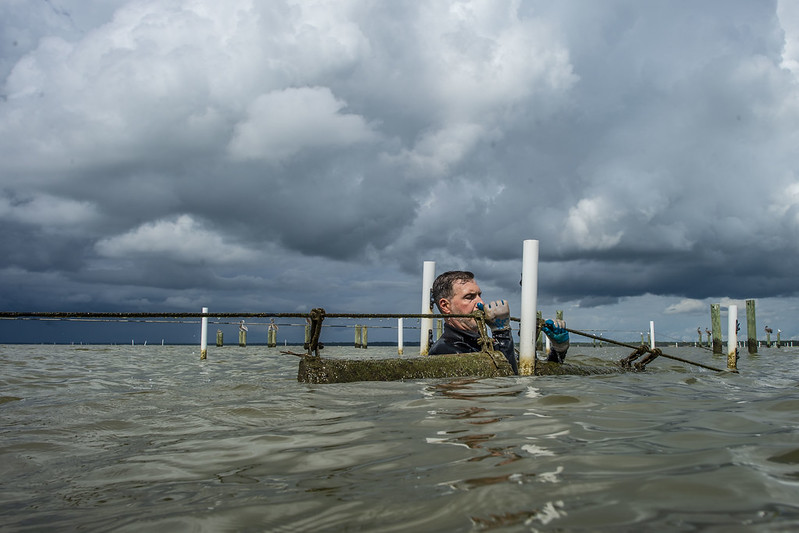Advancing Sustainable Aquaculture Production
The ARS aquaculture research program delivers new knowledge and technologies that improve domestic aquaculture production efficiency and product quality while minimizing impacts on natural resources. The following accomplishments in 2021 highlight ARS advances in trout yield, disease prevention, diets, and breeding.
Improved fillet yield and body weight in rainbow trout. The proportion of edible meat (fillet yield) on a carcass is of major economic importance and breeding animals with superior fillet yield can improve production efficiency and profitability. Animals must be slaughtered to measure fillet yield directly, so it cannot be measured in breeding animals. However, developing genetic gains for fillet yield is possible using information, including genome information, from siblings of fish that are potential breeders. ARS researchers in Leetown, West Virginia, compared the accuracy of genetic merit predictions for fillet yield between the family-based selective breeding—which used information about family relationships—and genomic selection, which used information about family relationships and genomic information. The genomic selection model increased the accuracy of genetic merit predictions for fillet yield by 50 percent, indicating that the use of genomic selection can enhance genetic improvement for the fillet yield trait and further enhance the efficiency and sustainability of rainbow trout aquaculture.
Sticky fish eggs thwarted by milk. Hybrid striped bass eggs become extremely sticky after they are fertilized. In a hatchery, this results in the eggs clumping together, which limits availability of oxygen and enables fungal infestations. Both problems can destroy an entire batch of eggs. Fish farmers typically use tannic acid treatments to prevent egg adhesion, but it is costly and, if left too long, will form a hard layer on the surface, which can prevent embryos from hatching. ARS researchers in Stuttgart, Arkansas, investigated 12 candidate compounds to prevent stickiness and found that 10 percent whole milk treatment was the most effective strategy. As a result, the largest commercial hybrid striped bass hatchery immediately began using milk for their 2020 production; in 2021, the hatchery exclusively used the milk to prevent clumping and successfully produced 80.9 million larvae using methods developed by ARS.
Algae oil in fish diets is a viable alternative to fish oil. Competition for the limited supplies of long-chain, omega 3 fatty acids (“fish oil”) used in the production of farmed fish feeds has created the need to identify alternative sources of long-chain, omega 3 lipids. Vegetable oils have proven to be insufficient in providing the nutritional requirements for normal growth and well-being of marine finfish and do not provide the heart healthy nutrients valued by U.S. seafood consumers. ARS-funded researchers in Fort Pierce, Florida, and their collaborators demonstrated that oils from algae can produce the same long chain omega 3 fatty acids found in fish oils. These findings provide an alternative lipid source that will increase the capacity for raising high-quality marine finfish aquaculture products and meeting the nutritional needs of U.S. seafood consumers.
Breeding Nile tilapia for disease resistance does not affect harvest weight. Fish growth is economically important for farmers, so the relationship between growth and other traits that affect performance is paramount. ARS scientists in Auburn, Alabama, and industry stakeholders demonstrated that resistance to Streptococcus (S.) iniae and S. agalactiae is heritable and used these findings to developed improved lines of tilapia with increased resistance to these diseases. They examined data from eight generations of selective tilapia breeding, including data on survival following S. iniae/S. agalactiae infection, and did not find any significant associations between harvest weight and survival. These findings suggest that selectively breeding for disease resistance will not reduce tilapia harvest weight, and support using multi-trait selection as a potential strategy to balance growth and disease resistance.
 Keres, Preston. Auburn University School of Fisheries Associate Professor Dr. William “Bill” Walton rises the floating cages filled with their oyster research at the Shellfish Lab in Dauphin Island, Alabama.2018. USDA Photo. https://flic.kr/p/MMudpF
Keres, Preston. Auburn University School of Fisheries Associate Professor Dr. William “Bill” Walton rises the floating cages filled with their oyster research at the Shellfish Lab in Dauphin Island, Alabama.2018. USDA Photo. https://flic.kr/p/MMudpF

